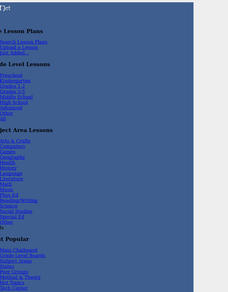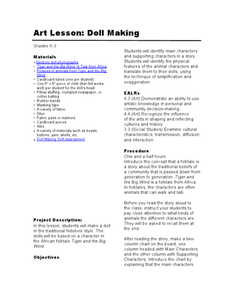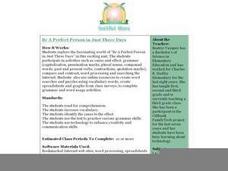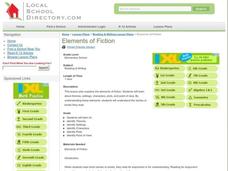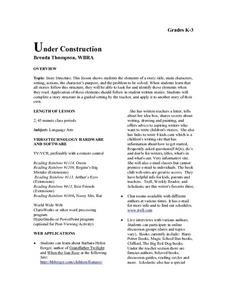Curated OER
Common Good
Students explore the concept of philanthropy. In this service learning instructional activity, students read stories and then discuss the meaning of philanthropy as they identify ways the characters contribute to the common good.
Curated OER
And the Moral of the Story is...
Students retell a story using computer software. In this story elements lesson, students retell the story giving the plot, setting, characters and moral using Pixie software.
Curated OER
Once Upon a Time
Students use Inspiration to Identify the defining characteristics of Fairy Tales, They create a literary web, study the basic structure of plot, and recognize that themes reoccur across literary works. They complete Once Upon a Time...
Curated OER
Venn Diagrams With the Pain And the Great One
Students read the story, The Pain and the Great One, written by Judy Blume, and discuss the characters and the sequence of events. They compare/contrast the two main characters using Venn diagrams.
Curated OER
Focus Story: The Mitten
Students explore language arts by analyzing a story with their classmates. In this poetry identification lesson, students read the book The Mittens and identify the characters, plot and settings in the story. Students recite poems about...
Museum of Disability
Zoom!
Turn your class' focus on how wheelchairs assist individuals with disabilities to become more independent with this disabilities lesson plan. Scholars listen to a read aloud of the book, Zoom! by Robert Munsch, answer...
Curated OER
Exploring the Mystery Genre
Students determine the story elements of typical mystery stories including characters and plot structure. They look at vocabulary that is common to mystery stories before reading and responding to mystery chapter books. Working in guided...
Pennsylvania Department of Education
Comparing Key Ideas and Details in Fiction and Nonfiction
Students recognize the differences between fiction and nonfiction texts. In this genre study instructional activity, students discuss what nonfiction means and write the definition. Students listen to a read aloud and vote whether the...
Curated OER
Ingredients of a Mystery
Learners explore the concept of mysteries. In this mystery genre lesson, students identify the common characteristics of mystery books and use a story map to identify these characteristics in a given book. Learners also...
Curated OER
Doll Making
Students discuss folktales and read Tiger and The Big Wind, listening for animal characters for later discussion. In this language arts lesson, students complete a T chart on characters and make a doll for one either chosen or assigned....
Curated OER
Writing Is Rough
Students identify the main idea in a story and discuss their own writing. They examine the sources of conflict in the story or the piece they are writing. They make portfolios of their best writing samples.
Curated OER
The Sorcerer's Apprentice
Third graders listen to "The Sorcerer's Apprentice". Using the music, they identify the high and low parts in the orchestal composition. They compare the elements of a story to the piece of music and respond to the music and state how...
Alabama Learning Exchange
The History of Space Exploration
Young scholars research and identify important events in the history of space exploration. They work in groups of three to four in order to research an important astronaut and record their finding on a poster board and present to the class.
Orange County Department of Education
Trapped by the Ice
Third graders read the story "Trapped by the Ice" which is about the Antarctic adventures of Sir Ernest Shackleton. They identify, write and share examples of respect and responsibility demonstrated by the stories' characters. Students...
Curated OER
Language Arts: A "Perfect" Lesson
Pupils read "Be A Perfect Person in Just three days," and participate in a host of activities. Connected to technology, they use online sources to create word searches and puzzles from vocabulary words. In addition, students create...
Curated OER
Elements of Fiction
Students identify key story elements in a fiction text. In this literacy lesson, students are introduced to the various elements of fiction such as the setting, plot, and theme. Students read a short story of their choice and identify...
Curated OER
Adapting a Fairy Tale
Students read and prepare a new oral version of a selected fairy tale. They read and compare/contrast two fairy tales and identify the main story elements. In small groups they create a new oral version of one they fairy tales and...
Curated OER
Book Letters
Young scholars study language. In this writing lesson, students listen to a story and then compose a friendly letter, about the book, to a friend. They work independently to compose their letter depicting what happened in the...
Curated OER
Frankenstein
Students use an outline of the story "Frankenstein" to identify mistakes in English. They practice making corrections to make the sentence correct. They answer questions to end the lesson plan.
Curated OER
Yes, You Can!
Students examine the concept of encouragement. In this encouragement and character lesson, students participate in an active read aloud of Mary Grace's, Amazing Grace. They draw a picture in their journal of a time that they needed...
Curated OER
Set the Scene
Third graders read the story "A Bargain for Frances" and make predictions about the unfolding plot of the story. In this set the scene lesson, 3rd graders examine the three parts of a story; the beginning, middle, and end.
Curated OER
Creating a Book Review Using a Multimedia Stack
Third graders identify the title, character, setting and plot of a story they have read. They state their opinions of the story read and provide information about themselves as a reviewer, using Multimedia Software.
Curated OER
Under Construction
Young readers examine the elements of story structure that are included in all stories. They include these elements in their own written pieces. This phenomenally-designed plan has everything you need to easily implement it in your...
Curated OER
Card Catalog Cards
Prepare students on how to use the library's card catalog system as well as the online version. Author, card catalog, the Dewey system, and so much more is addressed. This would be a great tool to use in the classroom or library.



